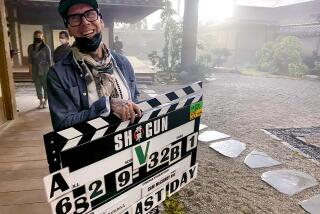Cinematographers of four of the yearâs top films describe key scenes
Often a single scene in a film can sum up the whole of the story in a far more emotional way than the most eloquent dialogue. Here, four cinematographers talk about their most evocative scenes from their current films and how they came to be:
âThe Theory of Everythingâ | BenoĂŽt Delhomme
The scene: Stephen Hawking and his future wife attend the traditional evening May Ball at Cambridge University.
Birth of the shot: âWe had the idea to make something quite magical and make the scene like a short story, a film within a film. We wanted to show the chemistry between them.â
Making it work: Because the scene was shot on location at Cambridge over two nights, âI wanted the actors to be very free, and I wanted to follow them with a Steadicam. I said to [director] James Marsh, âThe set is a big black hole â thereâs nothing there. In a film about Hawking, you donât want to create fake moonlight with cherry pickers. I want the light to come from the heart of the scene.â So I lit all these scenes with thousands of light bulbs. Also, we had Hawking visiting us on the first night of this scene. He was in a tent with a monitor watching what I was doing, so the pressure was even bigger.â
Shot significance: âItâs a crucial scene for the love story and the start of their journey.â
âMr. Turnerâ | Dick Pope
The scene: In the opening sequence of the film, painter J.M.W. Turner captures the orange-hued scene of a windmill at sunset.
Birth of the shot: Pope and director Mike Leigh âhad a talk about Turner physically walking through his paintings. It was incredibly important that we captured what Turner saw through his eyes.â
Making it work: The crew traveled in four-wheel-drive vehicles to a remote windmill in England, having already decided to shoot a simple, static scene as the sun set. But once Leigh worked out the scene with the actors on set, things changed. âI realized the way heâd staged it would require a very long tracking shot, and we had none of that equipment with us. The sun was sinking, but Mike and I decided to go for it. The grips rushed off to fetch the dolly and track, and we all paced around for a good 40 minutes. When they came back, we shot it, no rehearsal, and it was absolutely perfect. The delay in shooting was really fortuitous because it gave us the very best magical light.â
Shot significance: âYou feel what might have inspired him to paint.â
âInterstellarâ | Hoyte Van Hoytema
The scene: After an ill-fated planet landing during which many years have passed on Earth, Cooper breaks down while watching video messages from his now-grown son.
Birth of the shot: Director Christopher Nolan âwanted to be very close to our characters. We decided early on that on the spaceship we wanted to use a lot more wide-angle lenses. We were literally in their faces all the time with the hope of getting more of a connection with them.â
Making it work: âThat scene doesnât involve so much of the big gimmicks, but there are lighting challenges. When heâs listening, I have sunbeams hitting his face from time to time, and theyâre totally burned out. So you have this very strange physical obstacle of hard light hitting your actor. Even in this very quiet scene, you still feel those pounding elements getting in.â
Shot significance: âI felt very connected with this film [because of] those intimate, small scenes. It suited the idea of those people being stuck in confined places and so close to the elements of nature and surrounded by grandeur.â
âThe Grand Budapest Hotelâ | Robert D. Yeoman
The scene: In the middle of a gun battle on the fifth floor of the hotel, the camera pans around the atrium.
Birth of the shot: Director Wes Anderson created animatics [a kind of filmed storyboard] for each scene â complete with him doing all the charactersâ voices. âThe beauty of cartoons is you can draw things that have no relation to physical reality. Then itâs up to us to figure out the best way of going about doing it.â
Making it work: Because Anderson avoids a lot of modern equipment, Yeoman built scaffolding to get the shot, which pans in 90- and 180-degree motions. âI attached a laser pointer to the rods that support the camera, and then I put tape on the floor of the scaffold. I couldnât put my eye to the eyepiece; I had a video-assist monitor. I knew the dialogue well enough that I knew when I had to go to the next tape mark. It was a ballet of sorts with me running around this scaffolding with the camera, looking at the floor.â
Shot significance: Not only is the scene a critical point in the film, but Yeoman says it was the most technically difficult. âIt was quite a relief when Wes said, âOK, we got it. Letâs move on.ââ
More to Read
From the Oscars to the Emmys.
Get the Envelope newsletter for exclusive awards season coverage, behind-the-scenes stories from the Envelope podcast and columnist Glenn Whippâs must-read analysis.
You may occasionally receive promotional content from the Los Angeles Times.










